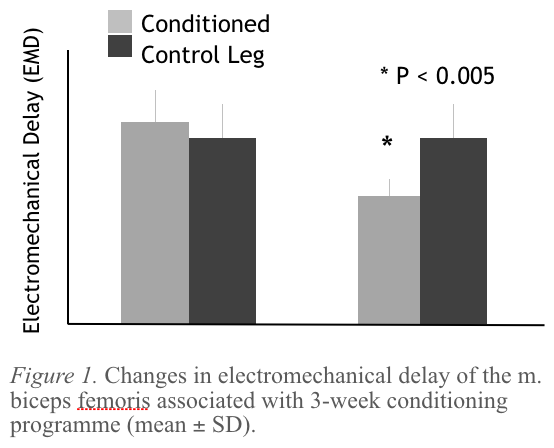Welcome to week 10 ! Before I start, if you’ve been reading this blog for a while and you have a burning question, or if you want me to cover a particular topic, please get in touch! I’d love to hear from you and I’d be delighted to answer any questions. Click the button below to be taken to the contact page, alternatively just tweet me @Claire_Minshull
So remember last week we introduced the index electromechanical delay, (EMD). Remember that it’s…
“…the time delay between the onset of muscle EMG and the onset of muscle force production.”
Today we’re going to look at if and how you can train it. But first, let us recap why this index is important.
EMD Increases With Injury & Fatigue
It also increases with deconditioning and ageing. We’re not going to go into the physiologic mechanisms that underpin each of these changes here and now, however, it is important to note that we’re probably dealing with a ‘slow to respond’ neuromuscular system in patients and people who are deconditioned. Just to be clear here, I don’t mean that the entire system will likely be slow, so for example following ACL reconstruction or an isolated hamstring tear the EMD of the upper limbs will not be affected, I’m referring to ‘local’ changes. That said, a person in significant pain may well consciously avoid maximal and rapid muscle contractions in general, but that’s another topic.
So, why is it important to be aware of this? Well in a rehab setting, performance of exercises involving high levels of unpredictability, perturbations and the need for rapid control of dynamic joint forces probably isn’t wise when we expect elongated muscle response times, whether they be resulting from acute fatigue, injury, deconditioning or otherwise. We don’t want to risk further injury! I’m aware that most wouldn’t do this anyway, but it’s a good reminder.
Training EMD
So, what can we do to quicken the muscle response times – to reduce the electromechanical delay?
Well, some of the key components of a fast EMD include:
- explosive muscle activation
- forceful muscle activation
- a ‘stiff’ system
So, to characterise the type of exercise to train EMD we need, fast, explosive and forceful muscle contractions. The reason for this is to recruit fast twitch motor units during this initial phase of contraction. Recruitment of these units mean a quicker and more forceful contraction and stretch of the compliant tissue in series with the muscle and a quicker application of force to bone. Remember last week where I compared this to a car towing another car – how we need to start the engine of the car in front, and then take up the slack in the tow rope before we can initiate movement?

Just like training strength we need to be specific (remember the specificity of training?) A good example of how specific we need to be can be seen from one of the first studies to experiment with training. Zhou et al (1996). recruited 6 males and put them through a 7-week sprint cycling training programme. Along with distance covered in a 30s sprint, they also measured neuromuscular performance. Not surprisingly the training resulted in an increase in distance covered during the sprint cycling test, but no changes to muscle strength, rate of force development (RFD) or electromechanical delay were observed. Clearly we understand now that high-intensity, but prolonged and sub-maximal training protocols don’t have the specificity to elicit changes in EMD, strength etc.
Strength Training Can Work
As we’ve discussed previously, the characteristics of strength training involves lifting heavy weights for few repetitions. In deconditioned or non-resistance trained individuals, the neural adaptations (reduction in inhibition, fast-twitch recruitment, increased synchrony of firing etc.) can result in a reduction in EMD, hurrah! Also, over a longer period of time (approx 3+ months or so), the morphological changes associated with strength training can confer a reduced compliance in the system (for example, increased tendon stiffness), which may have a positive effect on EMD result in a faster transmission of force to bone.
Search the literature, and you’ll find several examples. One recent paper (Stock et al. 2016) showed that 4 weeks of twice weekly barbell back squats and deadlifts (2 sets of 5 RM per exercise) resulted in a decrease in EMD times of the knee extensors, but no change in the knee flexors of non-habitually resistance trained females. Looking at the group mean data, the values seem pretty high to me (~90ms for quadriceps), thus I’m not surprised by this change.
Relying purely on resistance training isn’t always a good idea, however. Jenkins et al (2016) showed no significant effect of 4 weeks of elbow flexor training at 80% of 1RM in non-resistance trained males on neuromuscular parameters, including EMD and early RFD. One could speculate that the load and, or, nature of the contractions (time-guided at 0.5Hz [2 secs per full contraction]) wasn’t specific enough to provoke the necessary neuromuscular adaptations.
Song et al (2018) utilised an isometric training programme: three times per week for 8 weeks at 70% intensity of 1RM of the elbow flexors of young males. They observed a decrease in EMD after 8 weeks of training, but not after 4 weeks. I’d hypothesise here that in participants naive to resistance training, a sub-maximal resistance training programme (with non-explosive muscle activation) at this level may provoke changes in tendon stiffness and drive any decreases observed in EMD. Indeed, studies that employ this type of training and observe the effects on non-contractile tissue stiffness via ultrasonographic imaging report increased stiffness over a similar time frame.
Other Training Studies
So what can we do to improve EMD in trained individuals or athletes? Perhaps contrary to your expectation, plyometric training doesn’t really work. I think the overload isn’t great enough, plus there’s the stretch-recoil issues going on with the compliant tissues.
For adaptations that are driven by neuromuscular changes (vs. long term training effects on tendon compliance), we really need an explosive, high force muscle contractions, dosed in sets that are short enough to avoid muscle fatigue, similar to how you’d structure a strength training set.
Here’s an idea for you: Single Leg Eccentric Catches. I’ve showed this video several times in talks that I’ve given over the past couple of years. The person in this video is learning this exercise, so it’s pretty slow and controlled. Once mastered 1 rep will take ~ 1 second. The basics are lift with 2 legs, explosively ‘catch’ the falling weight with one (Left leg in the vid), then use both legs to stop the weights crashing at the bottom. It’s a bit tricky to get used to for some people, but once mastered the weight should be sufficiently heavy that they are just unable to lift it with a single leg. The exercise requires a very high, very brief, explosive eccentric contraction of the musculature – so all the right parameters for fast twitch recruitment.
We actually tested this in a pilot study a few years back. We recruited 8 untrained females and trained one leg as in the above video for 12 sessions, condensed into 3 weeks, and used their untrained limb as a control. You can see the outcome on EMD below in the figure.

We saw a 38% improvement in EMD of the trained limb, which isn’t bad going. Interestingly, and as we hypothesised, we didn’t see any changes in muscle strength.
Summary
So, what to make of all of this? Yes you can train EMD and decrease the neuromuscular response times. For untrained, deconditioned and injured populations, some improvements may be seen with strength training, when the load are sufficiently high. In the short term, this may be due to disinhibition and neural adaptation associated with increased central drive and activation of fast twitch motor units etc., over the longer term, changes are more likely to be due to increased stiffness of non-contractile tissue in series with the muscle, such as the tendon. For trained individuals, you need to be more specific and most likely need very high force, brief muscle activations to improve EMD times from ‘average’ to ‘faster’
T’S HERE! Download your Free 14-page guide: Strength & Conditioning for Therapists
References
- Zhou et al (1996). Effects of fatigue and sprint training on electromechanical delay of knee extensor muscles. Eur J Appl Physiol Occup Physiol. 72(5-6):410-6
- Stock et al (2016). Muscle group specific changes in the electromechanical delay following short-term resistance training. J Sci Med Sport. 19(9):761-5
- Jenkins et al (2016). Full text.
- Song et al (2018). Full text
- Yavuts et al (2010). Full text & interesting paper: Effect of gender, age, fatigue and contraction level on electromechanical delay


